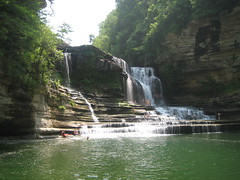How did I narrow it down? First, I had two non-negotiable requirements:
- I have to be able to afford an apartment, even if it's tiny (and they're all tiny); and
- It has to be a commute of less than 30 minutes via subway to my job, which is in Midtown Manhattan.
That still leaves a lot of Manhattan and parts of Queens, so that's where a second tier of considerations came into play. One, it has to be reasonably safe. I'm not paranoid, but I am a single female. (That said, distinguishing reports of real crime issues from "I don't feel safe around black and brown people" kind of comments is more work than it should be in 2011.)
Two, I want Stuff in the neighborhood. Grocery shops, coffee shops, that kind of thing. In my job, I don't always have to work on campus, so I want to be able to pop down the street and look busy at my laptop while eavesdropping on conversations about Sartre. (Kidding. Not a fan of Sartre.)
Third, I wanted ethnic and racial diversity. I'm not moving to NYC to live in a 88 percent white neighborhood, for crying out loud. But as recent images show, Manhattan is extremely segregated. Of course, income still tracks far too strongly with race in this country, so the more expensive the neighborhood gets, the whiter it also tends to be. And neighborhoods that are primarily non-white aren't necessarily diverse - witness Chinatown.
And therein lies the Hipster Trap (not to be confused with the art installation that made the rounds of the Internet recently). You want to live somewhere affordable with diversity, local institutions, personality, charming old buildings … and up-to-date-appliances, ready access to a Whole Foods, and a subway line. That way lies gentrification, and the loudest complainers about it are the very ones causing it. Oh, sure, the folks who got displaced complain too, but they don't get column space in the NYT to write about it.*
Which is to say, I wasn't sure there was a neighborhood that could give me everything I want, because I want to live a hip, post-racial, slightly socialized fantasy.
The thing is - I think I've found it. The runners-up all came close: One isn't in Manhattan, one offers terrible value for the money, another doesn't have very many residents and closes up shop at night. But this neighborhood, I think, can give me everything I'm looking for.
I'm afraid to actually say here what it is, as if that'll jinx it. I will say it is not a neighborhood anyone has suggested to me, as much as I appreciated everyone's suggestions. (Some more on target than others, of course.)
Now, I just have to get up there and see apartments in real life and convince a landlord to let me in.
*To be sure, this isn't as bad as government attempts at gentrification, as have happened in parts of Harlem, where municipally-incentivized developers hope that "if you build it they will come." They come - and take taxis home in fear after nights out in hipper neighborhoods, while complaining about the poor people and lack of Whole Foods.
